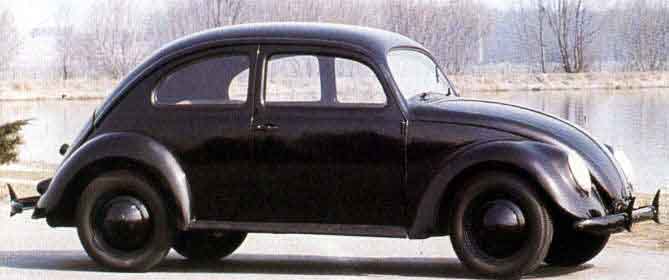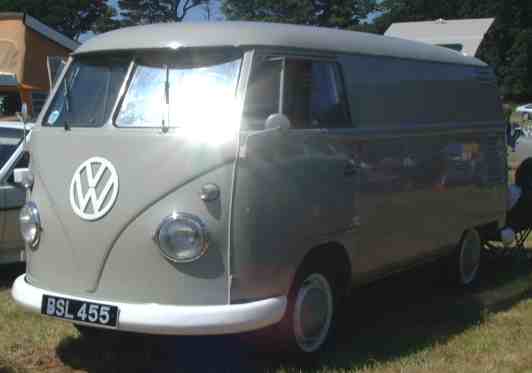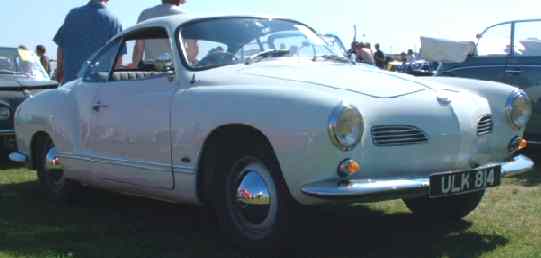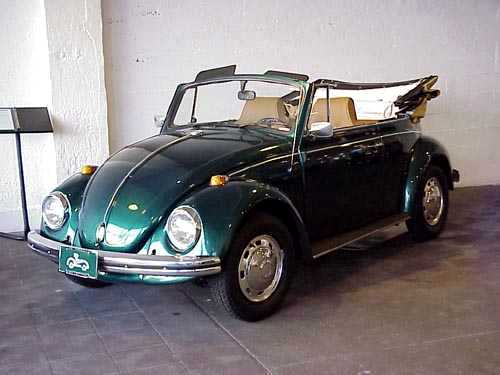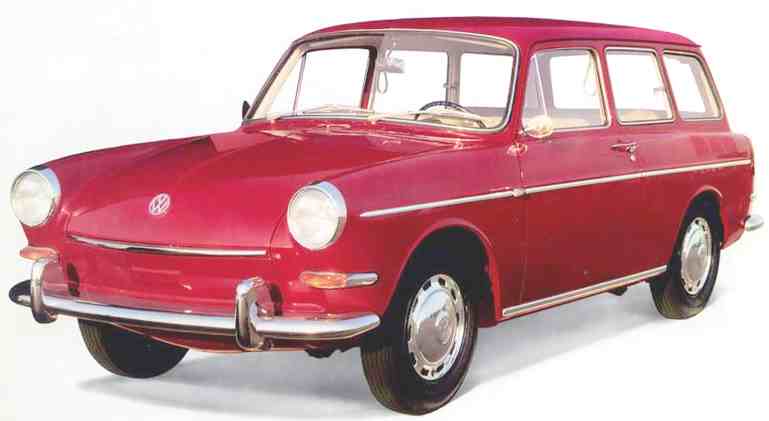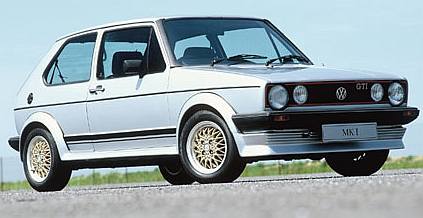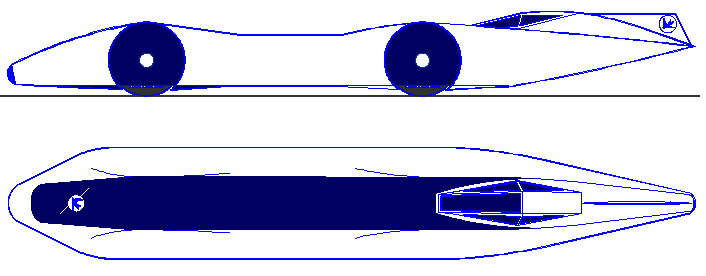|
Ferdinand Porsche & The Volkswagen Beetle
|
||||||
|
HOME | AUTOMOTIVE | ELECTRIC CARS | FORMULA E | ENERGY | INSURANCE | INDEX | SOLAR CARS |
||||||
|
The Volkswagen Beetle Car originated in Germany and is produced by the company Volkswagen. In German, Volkswagen means: People's Car. This Beetle has outsold every sort of car that has ever been made. It dates back to the early thirties and its history still grows as it continues to be produced. Production has now spanned over sixty five years and new technologies have been implemented along the way. Some of these are shown in the timetable below.
Literally, the word "volkswagen" means "people's car." In Germany, the idea of a people's car wasn't exactly a new one. Before the 1930's, there had been many efforts to create simple cars that everyone could afford, but none met with profound success. Almost all cars before 1930, even if they were designed to be simple enough for the average person, ended up costing more than the average worker's yearly wage.
VW Beetle (1938)
How The Beetle Began: In the early 1930's, Ferdinand Porsche and his company Dr.-Ing. h.c. Ferdinand Porsche GmbH designed a prototype of the Beetle Car. It was a streamlined sedan with a rear engine so that the driveshaft would be shorter, whilst the weight of the engine would still be distributed safely. This prototype was built by a motorcycle producer called Zundapp and test driven in 1932. It did not go into production though because Zundapp decided to keep making motorcycles as they were in high demand.
It is a little known fact that Professor Porsche worked with electric vehicles in the early 1900's. Porsche used a wheel motor in the hubs to propel his vehicles and later when working with the Lohner company, they produced four wheel drive electric vehicles. Later still Professor Porsche worked with Mercedes on an electric hybrid vehicle, where a petrol engine drove a generator which powered the electric traction motors of the "Mercedes Mixt."
Adolf Hitler at this time had a vision of his countrymen being able to own a cheap car and had plans on creating great networks of roads called autobahns. Hitler invited Porsche to submit to him a design for this peoples car, it had to be cheap, economical, fast (all of 60 miles per hour) and to accommodate two adults and three children comfortably. So, in January 1934 Porsche gave Hitler a proposal for his car and by June that year work had begun. Some funding was given by the RDA (Reichsverband der Autmobilindustrie - the German Auto Dealers Association), to help pay the bills!
In 1930 Ferdinand Porsche had just set up an automotive design company, which became known as the Porsche Büro. The company patented a sophisticated independent front suspension system, which consisted of transversely mounted torsion bars connected to two trailing arms on each side. At the time, this was lighter than most other common types of suspension. In 1931, a German motorcycle company, Zündapp, asked Porsche if he could design a suitable car for them. Porsche came up with a streamlined 2 door sedan, which had lines similar to the Beetle. It was designated the Type 12. Zündapp wanted to put in a 1.2 liter radial engine from one of their motorcycles...this was the end of the line for this design, as it didn't make it any further.
Porsche then designed a car for NSU in 1933 that was known as the Type 32. This car looked even more similar to the upcoming KdF Wagen than the Type 12 did. This car looked similar to the Tatra V570, and shared many mechanical similarities. After World War II, the Volkswagen company paid Tatra for compensation, since Tatra believed its technology and design was pirated in development of the KdF Wagen. Eventaully, NSU dropped the Type 32 project.
Later in 1933, Adolf Hitler met with Ferdinand Porsche to discuss Hitler's idea of a volkswagen. Hitler proposed a people's car that could carry 5 people, cruise up to 62mph, return 33mpg, and cost only 1000 Reich Marks. This was an opportunity for Porsche to push his idea of a small car foward, as was it to help Hitler get a real people's car for the citizens of Germany.
Initially, Porsche designated this design the Type 60, but it was soon changed to the V1 (experimental 1). Hitler also proposed to have a convertible version produced: it was designated V2. Porsche was not able to make the deadline to finish the first two prototypes, as there was not enough time to physically design the cars and to built them. In any case, they were completed and driving by 1935. Soon, the V1 design was updated, and three cars were produced. This new design was the VW3. These cars were put through rigorous testing in 1936.
Split screen VW van
These cars looked very similar to the KdF Wagen, that was to appear later. Eventually, the VW3s had metal floors, swing axle rear transmissions, Porsche's front independed suspensions, and backbone floorpans. Several engines were tested, and eventually a flat four cylinder aircooled four stroke engine was chosen. Surprisingly, the engine that was chosen was cheaper and more reliable than some of the four cylinder two stroke engines that were tested. This 22.5 hp four cylinder "boxer" engine was roughly the same as the engines that would later be incorporated into Volkswagen Beetles that are still produced today.
After data was collected from the tests of the VW3s, the next version, the VW30 was created, and in all, 30 were produced. Due to Hitler's regime, control of the company and testing of the VW30 was given to a government organization called the DAF. Now, members of the SS were required to drive the VW30s to confirm that all the problems of the V3s were fixed. For the most part, these tests showed that most of the problems in earlier cars had been fixed.
The three 1936 prototypes didn't even have rear windows but this soon changed. By 1937 30 prototypes had come out of the factory and were tested for faults. In May 1938 Hitler laid the foundation stone of the Volkswagen Beetle GmbH factory at Fallersleben, near Hanover and he also had a town called Kraft durch Freude Stadt (this name comes from Hitlers motto "Joy through Strength") built for the factory workers. Hitler also decided that this new car of the people was also to be known as the KdF-wagen, (short for the "Joy through Strength" car).
In 1938, construction began on the KdF Wagen factory, and on the town that was going to be next to the factory. In 1939, several VW38s (pre-production) and VW39s (demonstration cars) were produced just to show that the factory did work, and to show what the final version of the car would look like. These cars were different from their predecessors in that they had front hinged doors (all the VW designs before had "suicide" doors), split windows in the rear, larger hoods, and many other minor differences. This edition of the car was the basis of the Beetle after the war was over.
When the V38s were introduced, Hitler abruptly changed the name of the car to KdF Wagen. KdF stood for "Kraft durch Freude" which meant "Strength through Joy." This upset Porsche, as he was not a member of the Nazi party, and he didn't support Hitler's use of propaganda when advertising the car.
Finally, in April 1939 production started on the KdF-wagen but only 210 were made before World War 2 (1939-1945) disrupted the Western World and bombing ruined the factory. During the War production ceased but by 1946, the 1000th Beetle Car had rolled out of the factory and the town of KdF had been renamed to Wolfsburg after Werner von Schulenberg of Wolfsburg who had been forced to give up his land for the building of the town and factory. This was a much simpler car than those we jump into today. Cars produced during 1946-1948 had a rear window with a split down the middle, so it was really two windows and indicators popped out from a space between the front and back doors. There was a rear brake light that looked suspiciously like a nose and the petrol tank was hidden under the hood - there wasn't even a petrol gauge, but there was a speedomoter!
From 1945-1947 the British Military ran the factory before handing it back to Germany in 1948. By the end of that year nearly a quarter of the Beetles produced were exported, mainly to Europe. This was just the beginning for the Beetle Car's international trip to fame.
Karman Ghia - based on Beetle floorpan & engine
The years1940
The German government sold special stamps that could eventually be used to purchase a real KdF Wagen. In theory, as soon as 200 stamps were collected, they could be redeemed for a car. However, the KdF Wagen was not to be, and it never progressed beyond the prototype/demonstration stage. In later years, many people who collected these stamps took Volkswagen to court seeking compensation, since VW never made good on the KdF stamps. The KdF Wagen factory was busy pumping out Type 82s: Kübelwagens.
The Kübelwagen was a simple looking military vehicle that basically used the same parts as the KdF Wagen, but had a flat-sided body, and increased ground clearance. It was essentially the Germany's "jeep" in WWII. During the war, the company also produced an amphibious vehicle, which was known as the Type 128, and later as the Type 166: the Schwimmwagen. This vehicle was powered by a 25hp engine, and had a retractable ducted propeller in the rear for water use. In the water, the Schwimmwagen could achieve up to 5mph, and surprisingly steered in the water with its front tires. There were over 50,000 Type 82s produced, and less than 16,000 Schwimmwagens produced during the war. There were several military off-shoots of the KdF Wagen produced during the war:
Kommandeurwagen: KdF Wagen with ragtop sunroof, four-wheel drive, increased ground clearance
Papler: The Papler company built several four door versions of the KdF Wagen for use in parades and for police
Hebmüller: Hebmüller produced hundreds of custom two seat KdF Wagen convertibles
Porsche even experimented with very unusual powerplants, such as a wood-gas engine, compressed CO2 engines (very short range), and more.
The KdF Wagen factory was a prime target for allied forces during the war, and before long, it was partially destroyed. After the war was over, the British Army took over the factory. The British were interested in the factory, because they needed light transportation: what else could they do? The factory was brought back up (it was still damaged, however) with leadership provided by Major Ivan Hirst of the British Army, and by the end of 1945, had produced more than 2000 cars. Most of them were produced from spare parts that were left in the factory. Within a year, the factory had produced over 10,000 cars, all thanks to assistance from the British government. Sometime after 1945, the company was named Volkswagen by the British, who also renamed the town at the factory "Wolfsburg", which was the name of a local castle. The British sought to give control of the company to able hands: the Ford company turned the offer down because it thought it would be a waste of money, the French government refused; nobody seemed to want the company. In 1949, the British government was finally able to relinquish control of the company to the German government. Heinrich Nordhoff was appointed as the senior executive of Volkswagen, a move which proved to be a very good one.
VW Beetle cabriolet 1949
The 1950's
Beetle (1953)
After 1949, production at Volkswagen steadily increased. Nordhoff's experience and knowledge proved invaluable for the company. Late in 1949, an idea for a utility/transport vehicle was developed, and by 1950, the VW transporter was born.
Volkswagens were being exported to neighboring European countries such as Denmark, Sweeden, Luxemburg, Belgium, and Switzerland. As early as 1950, Volkswagen began producing Beetles in South Africa (They were now known as Beetles) as well. Volkswagen comissioned an old German coach building company, Karmann, to build their Beetle convertibles. Every single convertible Volkswagen Beetle was completed by Karmann: hence the special badges on VW convertibles. In 1952, a Volkswagen dealership was opened in England: which was the first there. A few Volkswagens were imported into the United States in 1949 by Ben Pon, but they didn't immediatley gain popularity. Very few were sold in their first year in the US.
The Hoffmann company of New York, which imported Beetles in the early 1950s, eventually abandonded Volkswagen, and imported Porsches instead. Volkswagen did not sell many cars in the United States until later in the mid-1950s.
Karman-Ghia (1955)
In 1951, Volkswagen began to export a deluxe version of the beetle. There was already a "standard" Beetle, which was only available in a dull gray color. These standard Beetles were spartan: they lacked synchromesh transmissions, exterior and interior chrome, and other special extra options that one might expect to have as standard in cars today. There were also regular export cars, that were available in several colors. The export cars also had chrome and more options as standard, such as a radio. The American export cars had even more chrome than regular export cars, and were generally the most elaborate with options and features. The American deluxe Beetles got hydraulic brakes in 1952, and lost their semaphores (flag-like turn signals) in 1955.
Volkswagen transporters were not as popular as Beetles, and in the first 5 years of production, there were 4 times fewer Buses built as Beetles. The Buses (and all other transporters) produced before 1955 had characteristically large engine access doors. Today, they are largely known as "barndoor" buses. Some people think that barndoor is supposed to be a reference to the side doors, but it is a misconception. These early barndoor transporters are very rare today.
Still in the 1950s, Volkswagen had already acted on its global goals by building factories in several countries. A factory began building Beetles in England, the plant in South Africa was building them, and a plant in Brazil provided a South American connection. Later, in 1960, a plant in Australia opened up, but never ended up being as successful as the other factories.
Karman-Ghia (1955)
Beetles built before 1953 (and some during that year) looked almost identical to the KdF Wagen designed before WWII. Midway in 1953, Volkswagen changed the rear split windows of the Beetles, and added a slightly larger oval window. This oval window was said to increase visibility out of the rear of the car up to 33%. By 1955, Volkswagen came out with a new model called the Karmann Ghia. It used many parts from the Beetle to keep production cheaper, and less complex. The Karmann Ghia was a joint venture by companies Karmann (builds VW Beetle cabriolets) and Ghia.
Volkswagen production kept increasing through the late 1950s. In 1958, the larger rear window that most people see in Beetles today (Ovals and Splits are much more rare than the larger window Beetles) was adopted. In each year, minor changes were made to the Beetle, and the other cars in Volkswagen's lineup, but nothing very drastic. Different turn signals were added, slightly improved engines, and other small things were common in the year to year changes. Volkswagen also had a very successful advertising campaign in the 1960s which helped contribute to its success in the United States. The Disney movie, Herbie, also helped promote the Beetle. The Herbie movies portrayed the Beetle as a "love bug." Later in the 1960s, Volkswagen produced over one million Beetles each year. 1969 was the most productive year for Volkswagen.
1960
After the Beetle's boom years in the late 1960s, its sales began to decline. In 1967, the transporter underwent major design changes, and in 1969 on US Export Beetles, VW added CV joints in the rear of the car in an effort to improve high speed stability on American highways. The traditional swingaxle system worked Ok, but at high speeds tended to lose stability.
VW Variant aircooled estate 1500 (1961)
1970
In 1971, Volkswagen developed a *new* car called the Super Beetle. The Super Beetle had modern MacPherson struts in the front instead of the older transverse beam arrangement it had since the 1930s: this new suspension allowed the trunk to be deeper, thus creating more luggage space in the front trunk. The Super Beetles of '71 had the same windshields as the standard Beetles did, but from '72-'74, a wrap around curved windshield was implemented. These were the only Beetles to have anything in the way of a real dashboard. Super Beetles were smoother cruisers on the highway, but did not make good Baja Beetle platforms. Ever increasing US government regulations on safety and emissions controls pushed the Beetle to its limits. The Beetle could not be adapted to keep up with the other cars in the industry. Volkswagen stopped production of the Beetle sedan in 1977, and stopped production of the cabriolet in 1979.
1979 - Volkswagen stopped production of the T2 camper van.
1980
1980 - Jan. 10th, Karmann finished producing the convertible Beetle. The last 4,572 conv. Beetles were sold in the US. Jetta, Vanagon and Rabbit Pickup were introduced.
1981 - 20 millionth Beetle was produced in Puebla Mexico.
1982 - Quantum was introduced to the US. Last year of production of the air cooled Volkswagen in Germany.
1990
1997 - A 1966 Beetle, owned by Albert Klein, was driven 1 million miles. Fox was introduced in the US.
1992 - Vento was introduced. No 1992 Transporter sold in the US.
1993 - Fox production ended.
1994 - Jan., Volkswagen unveiled the Concept One at the Detroit International Auto Show.
1995 - Sharan Van was introduced in Europe.
1997 - Camper conversion done by Winebego instead of Westfalia. VR6 introduced in the Eurovan
1998 - Jan,. Volkswagen unveil the production model New Beetle at the Detroit International Auto Show. Volkswagenism becomes a "cyber" religion.
1999 - Volkswagen releases next generation line up. Volkswagenism administration complete pilgrimage to Wolfsburg, Germany.
VW fortunes changes with the Gold Mk1 - a water-cooled front drive car
The Life Story of Professor Dr. "Ferry" Porsche
Although the company of Dr. Ing. h.c.F Porsche AG was formed on April 25, 1931 as "designers and consultants for land, sea and air vehicles," it was Professor Dr. Ferry Porsche, son of the automotive genius Professor Ferdinand Porsche, who steered the company into becoming one of the world's leading automotive engineering design companies and specialist manufacturer of sports cars. From the time he designed the first Porsche, the Type 356 in 1948, it was his personal involvement that made Porsche the great marque it is today.
When Ferdinand Anton Ernst Porsche, known as "Ferry," was born in Wiener Neustadt, Austria, on September 19, 1909, his father was Technical Director of the Austro-Daimler Company. Never far away from the automotive work of his father, Ferry Porsche was soon behind the wheel of a car and, by the age of twelve, was even permitted to run in the class winning Targo Florio car, the lightweight Austro-Daimler Sascha.
When the Porsche family moved to Stuttgart in 1923 for Professor Ferdinand Porsche to become the Technical Director of Daimler-Benz, the south German automotive center became Ferry Porsche's second home. It is there that he was educated and met his wife, Dorothea, she remained his staunch companion until her death in 1985, and was the mother of his four sons.
Ferry Porsche started working with his father when the latter formed his independent design office. Their first contract, designated number 007 to give the impression it was not their first project, was a 2-liter car for Wanderer. The success of this car was later to lead the newly founded Auto Union Company, which had incorporated Wanderer, to appoint Professor Porsche as the designer of a new Grand Prix car to meet the new 750 kgs. maximum weight formula.
The Auto Union was the most advanced pre-war racing car design concept. It was of lightweight construction, featured a 16-cylinder super-charged engine, with unique valve control mounted just behind the driver; an engine position which is standard for all modern generation F1 cars. Ferry Porsche played no small part in its design and construction. Less well known is the fact Ferry Porsche conducted much of the initial test driving of the car until his father declared one day, "I have enough drivers, but only one son."
One other car which the Porsche firm designed before World War II was to have an important influence on both Ferry Porsche and the rest of the world. It was, of course, the most produced car of all time: the Volkswagen Beetle. The war itself cut deep into the life of the young automobile designer. Transferred from demolished Stuttgart to the Carinthian town of Gmund in 1943, Ferry Porsche and a few colleagues had to start again from scratch in 1945 by keeping busy with repair jobs and the construction of simple farm machinery.
Meanwhile, the French held Ferry's father, Professor Ferdinand Porsche until 1947, when Ferry Porsche's family managed to raise sufficient money from new contracts in Italy to buy his freedom. One of these design projects resulted in the Cisitalia Formula 1 race car, unveiled at the Turin Motor Show that same year. It was the first race car with a midmounted engine and four-wheel drive.
After that, Ferry Porsche decided to build his own sports car, effectively the first "Porsche." He took out plans he made back in 1939 for a light, compact car based on the Volkswagen, practically the only components available in Germany at the time. Besides providing speedy acceleration, unmatched braking and good road holding, an essential criterion was the car had to be practical for everyday use. Its "marketing concept" adopted by Ferry Porsche was, "If I build a car that gives me satisfaction, then there must be others with the same sort of dreams who would be prepared to buy such a car."
The first car to bear the Porsche name, the Type 356, was delivered on June 8, 1948. It boasted a tubular space frame chassis, an aluminum body and a rear-mounted four-cylinder 1.131 cc VW engine. The following year, in order to ensure continued production of the 356, Ferry Porsche negotiated a new contract with the then head of Volkswagen, Heinz Nordoff, for the supply of parts. Besides this, the contract appointed Dr. Ing h.c.F Porsche K.G. as consultant engineer to VW, sole importer of VW's for Austria and recipient of a royalty sum on every VW Beetle produced at Wolfsburg.
A total of fifty-two 356 cars were built at Gmund in Austria before the company returned to Stuttgart. Production recommenced there in March 1950. During the same year, Porsche began designing its own engine, the Carrera. The 356 model, which was initially forecast to have a world sales potential of 500 units, was last produced in 1965 after over 78,000 cars had been built. The policy of model longevity is continued today with the Porsche 911, which enters its 35th year of production.
Professor Dr. Ferry Porsche was happy and grateful that his father witnessed with approval, shortly before he died on January 30, 1951, the start of Porsche as a specialist sports car manufacturer. Since 1948, decades of hard, dedicated work were put in by him to further enhance the Porsche product, which enjoyed a fine reputation from the beginning, by expanding customer service and marketing, not to mention accelerating product development through motor racing.
Since entering Le Mans in 1951 and achieving a class win, the name Porsche has been synonymous with success in motor sport. Amongst its numerous triumphs, Porsche has been crowned World Endurance Champion in sports car racing 14 times and, since 1970, has won the Le Mans 24-hour race a record 15 times. The world famous Monte Carlo rally was won four times by Porsche 911s, and an experimental 4WD 911 Carrera won the 1984 Paris-Dakar desert race first time out, the very first sports car ever to achieve this honor. Subsequently in 1986, Porsche 959s finished first, second and sixth on their debut outing in the event as well as becoming the first all-wheel drive racing car to enter and win its class at Le Mans.
In all, Professor Dr. Ferry Porsche demanded a great deal from his engineers, mechanics and drivers. He made courageous investments in new developments and thereby founded the worldwide reputation of his firm as a privately controlled, independent producer of technologically advanced sports and racing cars for worldwide use.
In 1972, the year the Porsche family withdrew from active management of the company, Weissach was opened. Today, Weissach is world famous as a site for research and development, where 30%, of all work is undertaken on behalf of other manufacturers, governments and NATO.
Back in 1965, Ferry Porsche was awarded an Honorary Doctorate by the Technical University of Vienna in recognition of his achievements in so many branches of the automobile world. In 1984 on his 75th birthday he was awarded the honorary title of 'Professor.'
BIOGRAPHICAL NOTES: PROFESSOR DR. ING. H.C.F PORSCHE - (1909-1998)
1909 Ferdinand Porsche was born in Wiener Neustadt, Austria on September 19.
1931 Began his activities as a designer in the engineering consultancy of his father, Dr. Ing h.c.F Porsche KG.
1932 Ferdinand Porsche's duties expanded to include supervision and coordination of testing. Assisted with the design and development of the Auto Union race car.
1934 Head of VW Testing
1935 Ferdinand Porsche became the Manager of the Research Department in the newly established Porsche test plant, Stuttgart-Zuffenhausen.
1935 Married Dorothea Reitz from Stuttgart (died 1985). They had four sons.
1938 Head of Development Department. In same year the design studio moved to a newly built building in Stuttgart-Zuffenhausen.
1940 Took over the post of deputy director for the entire operation.
1945 Ferdinand Porsche headed the firm, moved to Gmund in Carinthian during the war, and initiated development of the legendary Porsche 356, based on the Volkswagen and the first car to carry the Porsche name.
1948 The first 356 was completed in June.
1949 After completing the first 52 cars of this 356 range, Ferdinand Porsche with his company and most of his colleagues returned to Stuttgart-Zuffenhausen. Rebuilding of the consultancy offices for outside contracts took place.
1950 Production of the Porsche 356 began in Stuttgart-Zuffenhausen.
1959 Professor Theodor Heuss presented the Grosse Verdiensstkreuz (Commander's Cross of the Order of Merit) of the Federal Republic of Germany to Ferdinand Porsche in September.
1965 The Technical University of Vienna honored Ferdinand Porsche in November with the presentation of the title, Dr. techn. E.h.
1972 The Dr. Ing. h.c.F Porsche KG became a joint stock company (AG). Dr. Ferdinand Porsche assumed the post of Chairman of the Supervisory Board.
1975 Dr. Porsche received the Grosse Goldene Ehrenzeichen (Great Golden Cross Of The Order Of The Order Of The Order Of the Order of Merit) of the Republic of Austria in Vienna on January 31.
1979 On September 19, Lothar Spath, Prime Minister of Baden-Wurttemberg presented Dr. Porsche with the Grosse Verdienstkreuz mit Stern (Knight Commander's Cross) of the Bundesverdienstorden, on the occasion of his 70th birthday. 1984 A third of the entire Dr. Ing. h.c.F Porsche AG capital was offered to the public in the form of non-voting preference shares on April 25.
On September 19, Dr. Ferry Porsche celebrated his 75th anniversary and was awarded the honorary title of 'Professor.'
1985 The Guild of Motoring Writers Vice Presidents trophy for outstanding achievements in the field of automobilism was won by Professor Dr. Ferdinand Porsche. Honor of "Senator E.h." by University of Stuttgart.
1990- 1998 Honorary President of Supervisory Board, Porsche AG.
BACK TO BAHA LINKS PAGE | BAJA HISTORY
LINKS
http://
A taste for adventure capitalists
Is this the world's fastest electric car? Capable of 350mph + using energy from nature. Featuring built in battery cartridge exchange, charged using renewable solar energy. Partners & driver sought for the 2016 season.
|
||||||
|
The
content of this website is copyright © 1991 and 2017 Electrick
Publications. All rights reserved. The bluebird logo
|
||||||
